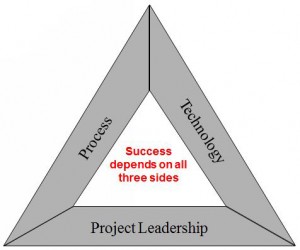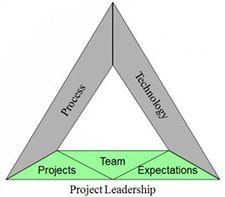
Figure 1: The triangle of success
In our three previous blog posts on the Triangle of Success, we discussed why business intelligence (BI) projects often fail and we examined the first two sides of our triangle (Figure 1). To recap, our sides are:
- Process
- Technology
- Project Leadership
A solid understanding of all three sides of the triangle will put you on the right road to a successful BI implementation. In this post, we will examine the components of our third side, “project leadership,” and discuss the components you need to consider for BI success, as well as the pitfalls you must avoid.

Figure 2: The components of project leadership
Step 3: Project leadership
When we talk about project leadership, we are really talking about the management aspect of our BI implementation – ensuring that people and resources are not overburdened, and expectations are reasoned and manageable. You’ll see in Figure 2 the components of project leadership: projects, team and expectations.
After you have defined your need (on the “process” side of our triangle), it’s time to break these needs down into digestible projects. Here, you need to ensure that you have the correct scope of projects and that you have the resources available to devote to them. You should also consider the timeline of your projects, as completion of one is often necessary before others begin. While it’s tempting to dive right in and try to get everything started once you’ve implemented a BI solution, you really need to understand the dynamics and synchronicities between projects and develop the right schedule and scope of each one.
Second, you need to think about what
teams
you need to support for your projects. Who will comprise each team? Do you have enough resources available?
Third, you need to come up with a set of
expectations
that need to be managed. This involves coming up with the right timeline and check-in points. Also during this phase, you need to consider how you will measure success and ensure that all stakeholders are on board with these expectations.
Project leadership pitfalls to avoid:
- Spreading your teams too thin. If you find that you have too much work for your team members, you’ll probably have to go back to the “projects” phase and consider either scaling back your projects or staggering them so you can adequately support each one.
- Failing to communicate issues that arise. Projects often stall because of a delay or problem that is not properly acted upon. It’s critical to make team members aware so that these issues are red-flagged and acted upon.
So far, we have constructed our triangle and examined the components of each side. But even if you master the nine components we’ve discussed, your BI project can still skid to a halt. That’s because each component of our triangle does not stand on its own – it’s part of an interconnected structure that depends on the other parts.
In our last blog post of this series, we’ll take a look at the relationships between these different parts of our triangle, and discuss how collaboration enables the parts to work well together to ensure BI success.
Blog posts in this series:
- Why BI Projects Fail – And How You Can Avoid Failure through the Triangle of Success
- The Triangle of Success – Understanding Process
- The Triangle of Success – Understanding Technology
- The Triangle of Success – Understanding Project Leadership
- Why Collaboration is Key to Enabling the Triangle of Success
- 3 Examples of How Hospitals are Using Predictive Analytics - February 15, 2018
- 3 Advantages to Using Simulation in Predictive Analytics - January 26, 2018
- Why the Time Is Right for Predictive Analytics in Healthcare - January 23, 2018

